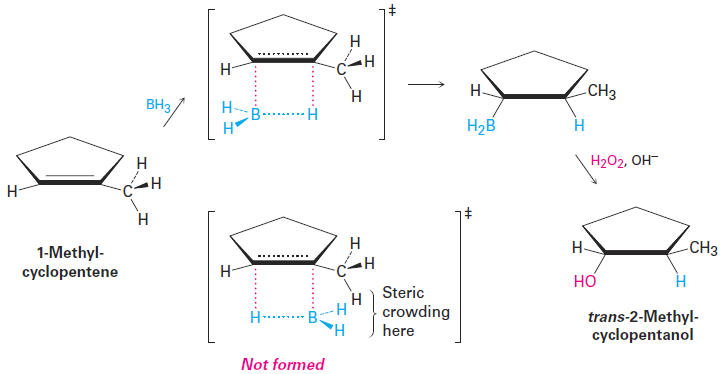
Hydration of Alkenes: Addition of H2O by Hydroboration
 المؤلف:
John McMurry
المؤلف:
John McMurry
 المصدر:
Organic Chemistry
المصدر:
Organic Chemistry
 الجزء والصفحة:
9th. p 230
الجزء والصفحة:
9th. p 230
 20-5-2017
20-5-2017
 2566
2566
Hydration of Alkenes: Addition of H2O by Hydroboration
In addition to the oxymercuration–demercuration method, which yields the Markovnikov product, a complementary method that yields the non- Markovnikov product is also useful. Discovered in 1959 by H.C. Brown and called hydroboration, the reaction involves addition of a B - H bond of borane, BH3, to an alkene to yield an organoborane intermediate, RBH2. Oxidation of the organoborane by reaction with basic hydrogen peroxide, H2O2, then gives an alcohol. For example:

Borane is very reactive as a Lewis acid because the boron atom has only six electrons in its valence shell. In tetrahydrofuran solution, BH3 accepts an electron pair from a solvent molecule in a Lewis acid–base reaction to complete its octet and form a stable BH3–THF complex.

When an alkene reacts with BH3 in THF solution, rapid addition to the double bond occurs three times and a trialkylborane, R3B, is formed. For example, 1 molar equivalent of BH3 adds to 3 molar equivalents of cyclohexene to yield tricyclohexylborane. When tricyclohexylborane is then treated with aqueous hydrogen H2O2 in basic solution, an oxidation takes place. The three C - B bonds are broken, - OH groups bond to the three carbons, and 3 equivalents of cyclohexanol are produced. The net effect of the two-step hydroboration–oxidation sequence is hydration of the alkene double bond.

One of the features that makes the hydroboration reaction so useful is the regiochemistry that results when an unsymmetrical alkene is hydroborated. For example, hydroboration–oxidation of 1-methylcyclopentene yields trans- 2-methylcyclopentanol. In this process, boron and hydrogen add to the alkene from the same face of the double bond—that is, with syn stereochemistry, the opposite of anti—with boron attaching to the less highly substituted carbon. During the oxidation step, the boron is replaced by an - OH with the same stereochemistry, resulting in an overall syn non-Markovnikov addition of water. This stereochemical result is particularly useful because it is complementary to the Markovnikov regiochemistry observed for oxymercuration– demercuration.

Why does alkene hydroboration take place with syn, non-Markovnikov regiochemistry to yield the less highly substituted alcohol? Hydroboration differs from many other alkene addition reactions in that it occurs in a single step without a carbocation intermediate (Figure 1.1). Because the C - H and C - B bonds form at the same time and from the same face of the alkene, syn stereochemistry results. Non-Markovnikov regiochemistry occurs because attachment of boron is favored at the less sterically crowded carbon atom of the alkene.

Figure 1.1 Mechanism of alkene hydroboration. The reaction occurs in a single step in which the C - H and C - B bonds form at the same time and on the same face of the double bond. The lower energy, more rapidly formed transition state is the one with less steric crowding, leading to non-Markovnikov regiochemistry.
 الاكثر قراءة في الهايدروكاربونات
الاكثر قراءة في الهايدروكاربونات
 اخر الاخبار
اخر الاخبار
اخبار العتبة العباسية المقدسة


